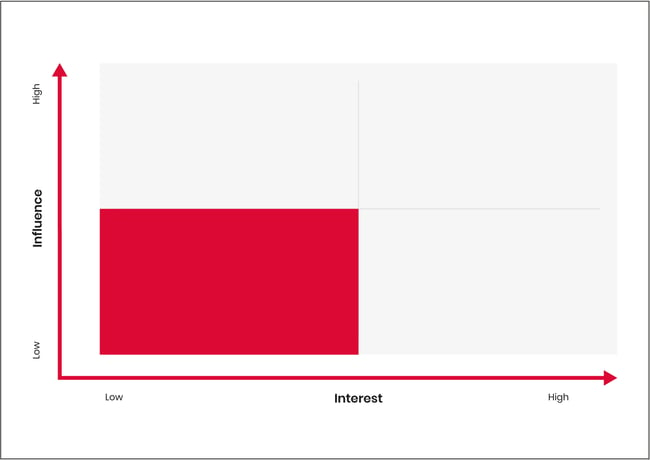This blog post is the last article of a 4-part series entitled "Beyond Stakeholder Mapping", which aims to explore the engagement dynamics and specificities each quadrant requires in the stakeholder mapping journey.
You can access the previous articles here: Part 1 | Part 2 | Part 3 or download the guide with all articles here:
Low-interest and low-influence stakeholders: the low-influence/low-interest quadrant
These are the others. They are the bystanders on issues upon which organisations have to decide.
Because they are obviously there, one cannot ignore them, but the general understanding has been that they are lowest in terms of priority.
Clearly, one should be conscious of them, and maybe invest a little in checking that they remain without much of a stake in what happens and ensure they haven’t suddenly acquired more influence than we thought. That’s all.

It has long been recognised that they need to be shown the same respect as others whose status may be different.
In training courses, we would illustrate this by advising that one would not send a letter by first-class mail to those in other quadrants but only use a second-class stamp for the Low-interest/Low-influence category.
The thinking was that there might be people out there who might take the view that “We may have little interest in this issue this time around … but at another time, we might, and we would want to be taken seriously…”
So, it is worthwhile to role-play a little and imagine how these parts of society might react to what is proposed.
There are degrees of indifference; that is why we normally use a ten-point scale so that there is sufficient granularity of analysis to tell the difference between those who may not have any consciousness of the issue, let alone an opinion, and those who are moderately aware, but recognise that they have neither a stake in or an appetite for any involvement.
Numerically, therefore, it is this category that represents the great bulk of society.
Unless the issue is all-pervasive and affects almost everyone, the High/High and High/Low quadrants are realistically occupied by tens of organisations and individuals, and the Low/High group – having more influence than interest – may number rather more. On this basis, though, the Low/Low quadrant contains thousands. Everyone!
That is why they are so important. This is the 360-degree perception of you as an organisation and the way in which you interface with your public.
Reputationally, how decision-makers conduct themselves over the wide generality of issues has a massive bearing on their standing in the community.
In general, there are few reliable indicators. Since the demise of the Audit Commission in England, there has been no systematic comparison of performance between local authorities.
Belatedly the new Office of Local Government partly rebuilds such a capability, and the new Best Value Guidance mentions as an ‘indicator’ of failure, a tokenistic or minimalist approach to public engagement.
Through stakeholder mapping there is, for the Low/Low quadrant, a lens through which to view how a consultor organisation approaches difficult issues.
Is it respectful of the entire community, ensuring that information is easily available and that the consequences of proposals are easy to appreciate?
Does it welcome participation or does it, either by accident or design deter people from involvement? Does it “invite” or does it “inhibit” participation?
The truth is that we are all stakeholders in a free society. Everyone of voting age has a periodic opportunity to express their opinion in the ballot box, but recent challenges to democratic values in the USA and elsewhere remind us not to be complacent.
If large elements of the population do not respect our institutions, it undermines the legitimacy of those in authority. If we treat the electorate with contempt; if we lie to them, or even if we are just ‘economical with the truth’, it erodes any right we have to the respect of the public.
Those in the Low/Low quadrant may lack the motive to engage and argue their corner which impels those with a high ‘interest’ in the issues(s). Neither have they the clout of high influence.
But they have the right to high standards of transparency, decision-making and public engagement/consultation. Stakeholder mapping is the opportunity to look at this group of people and to regard them as the bellwether of our reputation.
IN CONCLUSION, stakeholder mapping tells us more than just how best to engage with different elements of our audience.
In aggregate, they help us paint a picture of the wider world which most public bodies and many private Companies serve.
In detail, the lessons vary, but almost every organisation that conscientiously embarks upon such exercises has everything to gain and should be encouraged to invest in the methodology and how to use it.
Download the Beyond Stakeholder Mapping Guide:
Written by Rhion Jones
Rhion Jones was the Founder Director of the Consultation Institute and is an acknowledged authority on all aspects of public and stakeholder engagement and consultation. He advises Tractivity and will be contributing expert analysis and commentaries on current issues.
Rhion now publishes thought leadership articles regularly as the ConsultationGuru.


